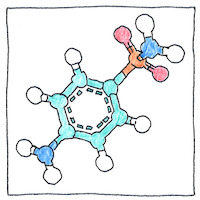Paul Gelmo,
Gerhard Domagk
pharmacology

|
Sulfanilamide
Paul Gelmo made a sulfanilamide for his doctoral work in 1908 and patented it the following year but was not aware that it worked as an antibiotic. A team led by Gerhard Domagk at Bayer, observing that certain dyes stained bacteria but not healthy tissue, for five years created dyes and tested them as antibiotics. Eventually, they found the sulfonamide Prontosil worked against streptococcus bacteria. Domagk didn’t realize until later that Prontosil metabolized in the body into a sulfanilamide, which Gelmo had already patented. Domagk used it to cure his own daughter who otherwise would have lost her arm. It cured president FDR’s twenty-two-year-old son of his strep throat, and clinical trials in Europe were also successful so that Prontosil became widely used— the first commercial antibiotic.
Antibiotics
Paul Gelmo didn’t invent antibiotics. Ancient Greeks and Egyptians used certain molds to treat infections. Louis Pasteur and Robert Koch in 1877 obseved antibiosis among bacteria. Alexander Fleming in 1928 discovered the mold that produced penicillin although methods for purifying penicillin weren’t available until after 1945.
Bacterial intruders
Suffering you don’t deserve inflicted as aching, nausea, fever. Your body puts survival ahead of comfort, as it reacts against the intruders. If your gravy boat were to arrive you wouldn’t feel like getting on. Thoughts of gravy, even thoughts of being well, remind you of diarrhea. Shall only the fittest survive, and shall the weak be undefended? Humans might merely be means for bacteria to populate the planet.



In a game of sport, one side wins and another side loses. In real life, if a disease decimates its host, the host at least can die.
See also in The book of science:
Readings in wikipedia: